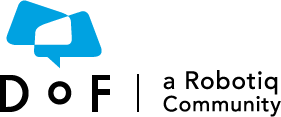Good job @Tyler_Berryman ! You might not need to do that in the next software update ;)
 Tyler_Berryman
Tyler_Berryman
@Kaleb_Rodes The logo does not need to be the exact same dimensions as the logo on the part. From my experience, I managed to locate a part that was about 10% smaller than the part that I taught to the vision system. Here is the post I wrote on this subject: http://dof.robotiq.com/discussion/461/using-the-gripper-to-bin-parts. This means that the logo doesn't have to be an exact 1:1 replica of the part's logo.
Regarding the camera's tolerance, the precision has not been completely specified. Here is a post that explains how to get the best precision from the vision system: http://dof.robotiq.com/discussion/comment/1511/#Comment_1511

 Etienne_Samson
Etienne_Samson
Hi DoF Community,
I am writing this post to show another "Hack" that allows you to increase the vision system's capabilities. The Robotiq Camera allows the user to teach an object to the vision system and this system will build an image template of the object. However, if the part is too big to fit in the camera's field of view, we have a small problem on our hands. To workaround this problem we can teach a specific feature of a part to the vision system. In this case, I wanted to teach the housing of an older version of a Robotiq gripper that is quite large. But I was having difficulties teaching the part to the vision system since the object was too large for the background. So I decided to teach the Robotiq logo to the vision system by printing the logo on a piece of yellow paper (The background).
I used this piece of paper as the object to teach to the vision system and I used another piece of yellow paper to act as the static background. The image template that was generated following the 5 pictures of the logo looked like this :
Then for the scanning process, I removed the paper version of the logo and placed the real part in the camera's field of view. The scanning process is used to refine the image template, so it is best to have the real part for this part of the teaching process. Once the scan was finished, I tested the detection of the logo on the real part and here are the results:
As you can see, I manage to build an image template that corresponds to a 97.6% match on the real part. This "Hack" can be used to identify a specific feature on a part that would be too large to teach to the vision system in its entirety. You could also use this method to inspect an assembly to verify that a specific part is present in the assembly. This could also be used to identify a specific feature of a large part, and then a Path Recording could be used to dispense glue in that feature.
In this demo, I am locating the Robotiq logo on the housing and I used a Path Recording to guide the tool around the logo.
https://www.youtube.com/watch?v=H94IRlWFwMc&feature=youtu.be